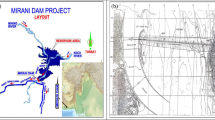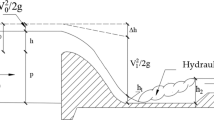Conclusions
-
1.
Baffle walls, stilling basins, and their combinations are the simplest and quite effective energy dissipators. Their hydraulic calculation methods for conditions of the two-dimensional problem have been developed rather reliably and cover a wide range of problems. Consideration of the working conditions of the outlet as an incomplete front, especially in the case of considerable nonuniformity, requires a further study, mainly with respect to estimating hydrodynamic loads, cavitation safety, and scouring.
-
2.
A dissipator in the form of one row of rectangular or trapezoidal piers is less effective than a solid wall, but has good dissipative action. The data of Figs. 2 and 4 can be used for calculation.
-
3.
Maximum hydraulic effectiveness with completely acceptable flow regimes can be provided by constructing near the contracted section two rows of piers (Fig. 1f) or their combination with a basin or wall; however, the possibility of the practical realization of such a scheme requires special substantiation with consideration of hydrodynamic loads and cavitation.
Similar content being viewed by others
References
T. P. Provorova, “Methods of hydraulic calculation of baffle walls and stilling basin,” Gidrotekh. Stroit., No. 8 (1987).
Hydraulic Calculations of Hydraulic Outlet Works: Reference Book [in Russian], Énergoatomizdat, Moscow (1988).
Guide to SNiP II-57-77.T.I. General Principles, Calculations of Concrete and Reinforced-Concrete Dams. Book 3. Handbook of Hydraulic Calculations: P-07-83/VNIIG [in Russian] (1983).
W. H. Hager and Li Damei, “Sill-controlled energy dissipator,” J. Hydraulic Research,30, No. 2 (1992).
J. Ohtsu, J. Yasuda, and Y. Yamanaka, “Drag on a vertical sill of forced jump,” J. Hydraulic Research,29 (1991).
T. P. Provorova, “Calculation of a combined dissipator in the form of the stilling basin supplemented by a baffle wall,” Izv. VNIIG,226 (1992).
F. W. Blaisdell, “Development and hydraulic design, St. Anthony Falls stilling basin,” Proc. ASCE,73, No. 2 (1947).
J. N. Bradley and A. J. Peterka, “Hydraulic design of stilling basin,” Proc. ASCE,83, No. HY5 (1957).
V. E. Lyapin, Energy Dissipators in the Form of Slotted Walls [in Russian], Gosénergoizdat, Leningrad (1960).
W. Rand, “Flow over dentated sill in an open channel,” Proc. ASCE,92, No. HY5 (1966).
S. M. Slisskii and É. P. Sandoval', “Reactive effect of block dissipators,” in: Proceedings of Hydraulic Engineering Conferences and Meetings. Methods of Research and Hydraulic Calculations of Hydraulic Outlet Works [in Russian] (1985).
A. S. Obrazovskii, “Calculation of conjugate depths of a jump occurring near trapezoidal dissipators,” Gidrotekh. Stroit., No. 5 (1954).
D. R. Basko and J. R. Adams, “Drag forces on baffle blocks hydraulic jump,” Proc. ASCE,96, No. HY12 (1972).
V. Mura Hari, “The drag on a baffle block under forced hydraulic jumps,” Water Power, No. 11 (1976).
M. J. A. Baig, S. K. Vali, S. S. Rao, and A. V. N. Chetty, “Forced hydraulic jump in rectangular channel of small slopes by sill of finite lengths,” Ind. Journal of Power and River Valley Development,34, No. 2 (1984).
R. Wanoschek and W. H. Hager, “Sill-controlled trapezoidal stilling basin,” Proc. 24th Cong. IAHR, V.D. 266 (1991).
J. McCorquadale and M. K. Girattalla, “Supercritical flow over sills,” Proc. ASCE,98, No. HY4 (1972).
D. M. Tyagi, P. K. Pande, and M. K. Mittal, “Drag on baffle walls in hydraulic jump,” Proc. ASCE,104, No. HY4 (1978).
D. V. Shterenlikht and A. B. Maslov, “Drag characteristics of block energy dissipators,” Gidrotekh. Stroit., No. 6 (1984).
K. S. Karki and S. Kumar, “Drag on vertical sill of forced jump (discussion),” J. Hydraulic Research,30, No. 2 (1992).
R. K. G. Raju, M. K. Kitaal, M. S. Verma, and V. R. Ganeshan, “Analysis of flow over baffle blocks and end sill,” J. Hydraulic Research,18, No. 3 (1980).
N. N. Pillai, A. Goel, and A. K. Dubey, “Hydraulic jump type stilling basin for low Froude number,” Proc. ASCE, J. Hydraulic Research,115, No. 7 (1989).
N. G. Bhowic, “Stilling basin design for low Froude number,” Proc. ASCE,101, No. HY7 (1975).
N. N. Belyashevskii, N. G. Pivovar, and I. I. Kalantyrenko, Calculations of the Lower Pool Beyond the Outlet Works on Nonrock Foundations [in Russian], Naukova Dumka, Kiev (1973).
A. N. Rakhmanov, “Erosional ability of a flow below baffle teeth,” Izv. VNIIG,70 (1962).
Additional information
Translated from Gidrotekhnicheskoe Stroitel'stvo, No. 10, pp. 6–11, October, 1995.
Rights and permissions
About this article
Cite this article
Provorova, T.P. Hydraulic calculation of energy dissipators. Hydrotechnical Construction 29, 562–569 (1995). https://doi.org/10.1007/BF02443044
Issue Date:
DOI: https://doi.org/10.1007/BF02443044




